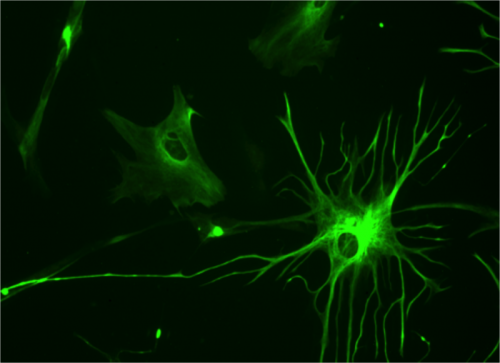Cancer is the second most common cause of death in the world. Almost one out of every six deaths can be traced back to this deadly disease. Science has made huge strides towards treating and curing cancer, but there are many different types of cancer, and no single cure that works for every case. Understanding the cause of each type of cancer is crucial to treating each patient, so much recent cancer research focuses on the genetic factors that cause normal cells to become cancerous.
Researchers at the Yale Systems Biology Institute led a team of scientists studying the genes involved in glioblastoma, a type of brain cancer. This cancer targets star-shaped support cells in the brain called astrocytes, which serve many purposes in the nervous system. Glioblastoma is one of the deadliest types of cancer. While over two-thirds of the people diagnosed with any type of cancer make it to the five-year survival mark and beyond, the median survival time for patients diagnosed with glioblastoma is between 1 and 1.5 years. The Yale-led team of researchers developed a technique enabling them to identify specific gene combinations that cause glioblastoma. They believe their approach could be applied to other types of cancer as well, which would revolutionize how we approach cancer treatment.
Cancer is caused by genetic mutations. However, even if two patients have the same type of cancer, the patients may or may not have the same mutations. Prior to the Yale-led study, genome sequencing identified 223 genes with links to glioblastoma. But that also means that there are hundreds of thousands of possible combinations of genes, with certain combinations responding slightly differently to treatment. Thus, the Yale researchers wanted to clarify how these different combinations affect glioblastoma treatment.
To do this, the Yale team employed the use of a technique called CRISPR. First pioneered in 2012, CRISPR is a gene editing technique that has revolutionized the biomedical sciences, by enabling researchers to create cells with mutations and test the effects of the mutations. However, CRISPR does have its limitations. To use this type of CRISPR, each combination would have to be tested one by one, which would be hard to compare since the time-intensive tests would give results two to three years apart.
To address this, the Yale-led team developed a novel CRISPR technique that is less biased, more time-efficient, and more cost-efficient. Rather than testing each individual mutation and waiting for the results of each experiment, which would exhaust both time and resources, the new technique employs a pool of viruses, each of which targets a specific gene. Infected from a pool of viruses, each mouse brain cell has the potential to have multiple mutations. Thus, the team could test for multiple combinations simultaneously. The researchers found specific combinations of mutations that could cause glioblastoma, as well as two combinations that could make the glioblastoma tumor resistant to chemotherapy.
By understanding the results of different combinations of mutations, doctors will be able to screen for these mutations and decide the appropriate treatments. For instance, if they find that a patient has the combination of mutations that cause a tumor to be resistant to chemotherapy, the doctors will know not to waste time and resources on an unsuccessful chemotherapy, which could further harm or discourage the patient. Information like this is especially important when the average survival time for cancers like glioblastoma is under two years.
The researchers believe that their approach can be applied to other types of cancer, which would allow doctors to give treatments specific to each case, hopefully leading to a higher chance of success. Sidi Chen, one of the investigators on the team, said, “In order to find better therapy or treatment, we need to find the therapeutic responder, or the genes that regulate or change some response. Now we have the tools—we have the experiment setting—we can simply do the same experiments but with gene therapy.” By using CRISPR to create the different glioblastoma-causing gene combinations and applying specific types of therapies to see how each combination responds, the scientists may be able to figure out exactly which treatment will work for each case of cancer. In other words, targeted “cures” for cancer may soon become an applicable reality.

